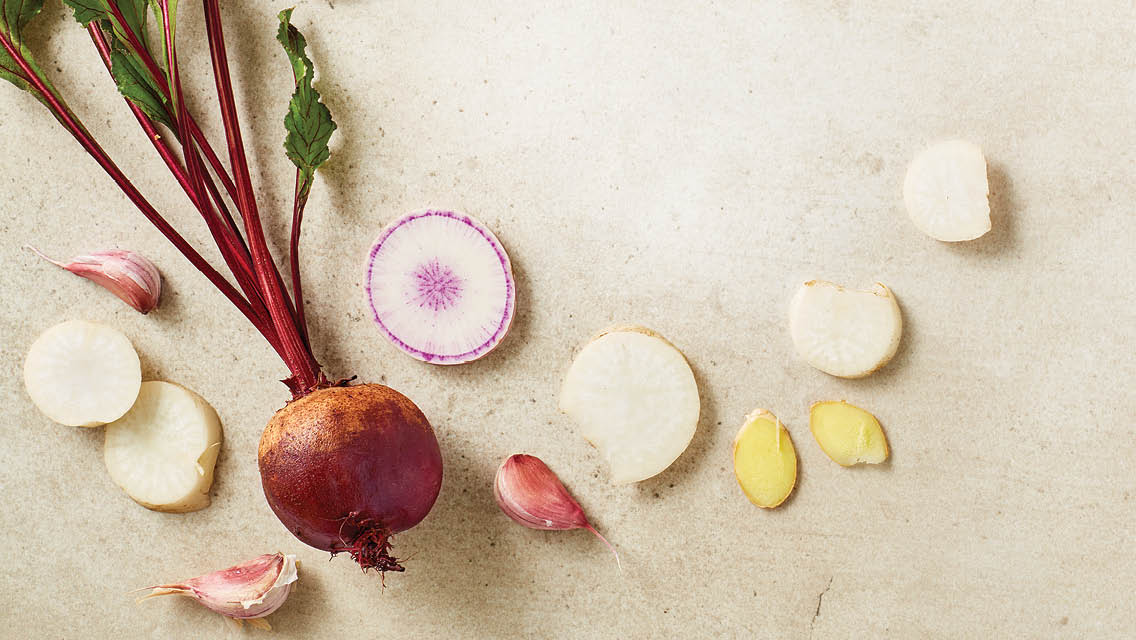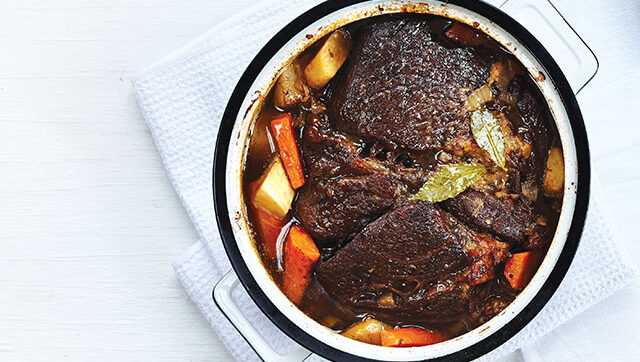Just as the leafy salads of summer fade away, autumn offers up a hearty selection of satisfying root vegetables. Earthy and nutritious, these long-storing delights are easy to prepare — and they bring warm comfort to your dinner table.
Food Basics
The edibles we call “vegetables” are harvested from many different parts of plants — tubers, roots, bulbs, stems, stalks, leaves or flowers. What we call “root vegetables” are actually a mix of tubers (potatoes, sunchokes), tuberous roots (sweet potatoes), taproots (carrots, parsnips), taproots/ stems (beets, celeriac, radishes, rutabagas, turnips), and bulbs (garlic, onions, shallots). Root vegetables will keep for several weeks (carrots, garlic, onions, radishes, beets) or up to two months (potatoes, rutabagas, turnips), making them a reliable and economical choice. For the best textures and flavors, select firm, fresh-looking, brightly colored root vegetables. Avoid those with shriveled skin, and do not eat greened potatoes, which contain abnormally high alkaloid levels.
Nutritional Know-How
Most root vegetables are good sources of vitamin C, a powerful antioxidant that also helps your body absorb iron. They also offer a range of other vitamins, phytonutrients and minerals: potassium (potatoes, radishes and parsnips), calcium (turnips), complex carbohydrates (potatoes), beta-carotene (carrots), vitamin B6 (potatoes), phosphor (turnips), folate (radishes), magnesium (turnips) and vitamin B (beets). (For more on beets, see “Beets”.) Combine them in dishes for a healthy and varied mix of nutrients. Because most root vegetables are filling and relatively starchy, they make a great substitute for grain-based dishes like pasta and white rice.
Eat Up!
- Roasting root vegetables brings out their sweetness. Prepare a mix of any of the following: carrots, parsnips, turnips, rutabagas, beets or potatoes. First scrub, then peel if necessary (see Kitchen Tricks, below, for tips). Cut into desired shape and size (fast-cooking vegetables, like potatoes, should be cut larger than slow-cooking carrots, parsnips, turnips, rutabagas and beets), toss with olive oil or melted butter, then add salt and pepper. Roast at 450 degrees F for 45 minutes, stirring every 10 minutes.
- Assertive fresh herbs like rosemary and thyme nicely complement root vegetables, but they should be added during the last 15 minutes of cooking to prevent them from burning.
- To thicken and brighten puréed soups, add potatoes or parsnips when cooking the rest of the ingredients. Cook until veggies are softened, then purée entire soup. This addition replaces the need for a roux (the flour and butter mix often used to thicken soups and sauces) or cream.
- Elevate simple mashed potatoes by combining with parsnips, carrots, turnips or sunchokes before mashing.
- Boil, steam or bake fingerling potatoes and drizzle with olive oil. Then add sea salt, ground black pepper and fresh herbs.
Kitchen Tricks
- Store root vegetables (except potatoes) loosely covered in the refrigerator, where they will keep for three to four weeks. Potatoes are better off in a cool, dry drawer or basket (remove any plastic bags!).
- The skins of root vegetables hold many of their nutrients. Very young, fresh roots like beets and turnips are fine to enjoy with their nutritious skin intact, but older, larger, thick-skinned root vegetables require peeling.
- Avoid cooking turnips in aluminum or iron pots. Their flesh contains anthoxanthin pigments that interact with these metals. Though still edible, the turnips will turn an unappealing grayish color.
Roasted Root Vegetables
Makes eight servings
- 2 medium parsnips, peeled, cut into 2-inch sticks
- 2 medium carrots, peeled, cut into 2-inch sticks
- 2 medium beets, peeled, cut into 2-inch sticks
- 2 medium sweet potatoes, peeled, cut into 2-inch sticks
- 2 tsp. extra-virgin olive oil
- 1/2 tsp. sea salt
- 1/4 tsp. freshly ground black pepper
Directions
- Preheat the oven to 450 degrees F (230 degrees C). Place the vegetables on a baking sheet.
- Mix the vegetables with the olive oil. Season with salt and pepper.
- Roast until browned and al dente (slight bite remaining) for 45 minutes, stirring every 10 minutes.
Pear-Parsnip Soup
Makes eight servings
- 1/4 tsp. extra-virgin olive oil
- 2 cups chopped yellow onions (about two large)
- 9 cups chopped, peeled parsnips (about 4 1/2 pounds)
- 4 cups chopped, peeled pears (about six medium)
- 2 cups diced, peeled Yukon gold potatoes (about 1/2 pound)
- 8 to 9 cups vegetable stock
- 1 tsp. freshly grated nutmeg
- 2 tsp. chopped fresh thyme
- 1 tsp. sea salt
- 1/2 tsp. white pepper
Directions
- Heat the olive oil in a medium saucepot over medium-high heat. Add the onions, parsnips, pears and potatoes. Cook until the onions have softened, about two minutes.
- Add the stock and bring to a boil. Reduce heat and simmer until parsnips and potatoes are soft, 15 to 20 minutes.
- While the soup is simmering, stir in the nutmeg and thyme to blend the flavors into the soup.
- Carefully ladle the soup into a blender and blend until smooth. Strain the soup through a fine mesh strainer or a colander lined with cheesecloth to remove any pulp. Return the strained soup to a pan and heat until hot.
- Season with salt and pepper.
Celeriac Salad
Makes four servings
- 1 cup julienned celery root, (celeriac) blanched
- 1/2 cup julienned carrot
- 1/2 cup julienned zucchini, just green outside
- 1/2 cup julienned Granny Smith apple
- 1/4 cup chopped celery
- 1/4 cup capers
- 1/2 cup mayonnaise
- 2 tbs. lemon juice
- 1 tbs. chopped fresh parsley
- 32 endive leaves
Directions
- In a large bowl, toss together the celery root, carrot, zucchini, apple, celery and capers.
- In a small bowl, whisk together the mayo, lemon juice and parsley. Add the mayo mixture to the salad and mix gently.
- To serve: Divide salad among four small salad dishes to serve.
This article has been updated. It originally appeared online on October 1, 2008.




This Post Has 0 Comments